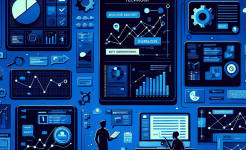In the realm of project management, effectively tracking progress is crucial for the success of any endeavor. Two powerful tools that have gained significant popularity are the burndown chart and project progress tracking mechanisms. When these two are combined in a harmonious way, they offer project managers and teams a comprehensive view of the project's health, enabling them to make informed decisions, identify potential issues early on, and ensure that projects are completed on time and within budget.
The burndown chart, at its core, is a visual representation of the work remaining in a project over time. It provides a clear picture of how much work is left to be done and how quickly the team is progressing towards completing that work. Project progress tracking, on the other hand, encompasses a broader set of activities that involve monitoring various aspects of the project such as tasks, milestones, resources, and risks. By integrating these two concepts, project teams can enhance their ability to manage projects more efficiently and effectively.
This article will delve into the details of how the burndown chart and project progress tracking can be combined to create a perfect synergy. We will explore the benefits of this combination, how to create and use a burndown chart effectively, and how it fits into the overall framework of project progress tracking. Additionally, we will look at real-world examples and best practices to illustrate the practical application of this powerful combination.
Understanding the Burndown Chart
The burndown chart is a simple yet highly effective visual tool. It typically has the time axis on the x-axis, which can be in days, weeks, or any other appropriate time unit depending on the project's duration. On the y-axis, it represents the amount of work remaining, which can be measured in terms of story points, hours, or any other unit of work that the project team has defined.
The chart starts with a certain amount of work at the beginning of the project or a specific iteration. As the team progresses and completes tasks, the amount of work remaining decreases, and this is plotted on the chart. A straight line, known as the ideal burndown line, is also drawn on the chart. This line represents the rate at which the work should be completed if everything goes according to plan.
By comparing the actual burndown line (the line representing the real progress of the work) with the ideal burndown line, project managers can quickly identify if the project is on track, ahead of schedule, or behind schedule. If the actual burndown line is above the ideal line, it indicates that the team is falling behind, while if it is below the ideal line, the team is ahead of schedule. This visual representation makes it easy for everyone involved in the project, from team members to stakeholders, to understand the project's progress at a glance.
Moreover, the burndown chart can also help in predicting when the project will be completed. By analyzing the trend of the actual burndown line, project managers can estimate the remaining time required to finish the work. This prediction can be used to adjust plans, allocate resources more effectively, and communicate realistic timelines to stakeholders.
The Role of Project Progress Tracking
Project progress tracking is a multifaceted activity that involves monitoring various elements of the project. It includes keeping tabs on individual tasks, ensuring that they are completed within the allocated time and meet the required quality standards. Milestones, which are significant points in the project timeline, are also closely monitored. Achieving milestones on time is an important indicator of the project's overall progress.
Resources are another critical aspect of project progress tracking. This involves making sure that the right resources, such as personnel, equipment, and materials, are available when needed. If a resource shortage occurs, it can delay the project. Additionally, tracking resources helps in optimizing their utilization, ensuring that they are not under- or over-utilized.
Risk management is also an integral part of project progress tracking. Identifying potential risks early on and having a plan to mitigate them is essential. By continuously monitoring the project for risks, project managers can take proactive measures to prevent or minimize their impact on the project's progress. For example, if a risk such as a potential delay in the delivery of a key component is identified, the project team can explore alternative suppliers or adjust the project schedule accordingly.
Project progress tracking also involves communication. Regular updates to stakeholders about the project's status are necessary to keep them informed and engaged. This helps in building trust and confidence in the project team's ability to deliver the project successfully.
Benefits of Combining the Burndown Chart and Project Progress Tracking
One of the major benefits of combining the burndown chart and project progress tracking is improved visibility. The burndown chart provides a clear visual of the work remaining, while project progress tracking offers detailed information about the various aspects of the project. Together, they give project managers and stakeholders a comprehensive view of the project's health.
This combination also enables early issue detection. The burndown chart can quickly show if the project is deviating from the planned schedule, and project progress tracking can help in identifying the root causes of these deviations. For example, if the burndown chart shows that the project is falling behind, project progress tracking can reveal whether it is due to a lack of resources, a problem with a particular task, or an unforeseen risk.
Another benefit is better decision-making. With accurate and up-to-date information from both the burndown chart and project progress tracking, project managers can make more informed decisions. They can decide whether to reallocate resources, adjust the project schedule, or take other corrective actions to keep the project on track.
In addition, this combination enhances team communication. The burndown chart serves as a common visual reference for the team, and project progress tracking provides the details that support discussions about the project's progress. This helps in aligning the team's efforts and ensuring that everyone is working towards the same goals.

Creating and Using a Burndown Chart Effectively
To create a burndown chart, the first step is to define the work units. This could be story points in an agile project or hours of work in a more traditional project. Once the work units are defined, the total amount of work at the start of the project or iteration is determined.
Next, a time frame needs to be established. This could be daily, weekly, or monthly updates depending on the project's nature. As the project progresses, the amount of work completed is recorded, and the remaining work is calculated and plotted on the chart.
When using a burndown chart, it is important to analyze the trends. A consistent upward or downward trend in the actual burndown line can indicate whether the team is performing better or worse than expected. If the chart shows a significant deviation from the ideal line, it is time to investigate the reasons. This could involve talking to the team members, reviewing the task assignments, or looking at the resource allocation.
Moreover, the burndown chart should be shared with the entire project team and stakeholders. This promotes transparency and allows everyone to have a clear understanding of the project's progress. Regular discussions about the burndown chart can also help in identifying areas for improvement and making necessary adjustments.
Integrating the Burndown Chart into Project Progress Tracking
The burndown chart can be seamlessly integrated into the overall project progress tracking framework. It can serve as a high-level summary of the project's progress, while the detailed tracking of tasks, resources, and risks provides the underlying data.
For example, when a risk materializes and affects the project's progress, the burndown chart can show the impact on the overall work remaining. At the same time, the project progress tracking system can provide the details of how the risk was managed and what steps were taken to minimize its impact.
In terms of resource management, the burndown chart can indicate if the allocated resources are sufficient. If the project is falling behind, it could be a sign that more resources are needed. Project progress tracking can then be used to identify which resources are lacking and how they can be obtained.
Milestones can also be incorporated into the burndown chart and project progress tracking. The achievement of a milestone can be marked on the burndown chart, and the project progress tracking system can provide the details of how the milestone was reached and what tasks were involved.
Real-World Examples and Best Practices
In many software development projects, the combination of the burndown chart and project progress tracking has proven to be highly effective. For instance, a software development team was working on a new application. By using a burndown chart, they could clearly see that they were falling behind in the development of a key feature. Through project progress tracking, they discovered that it was due to a lack of expertise in a particular technology. They were then able to bring in an external expert, adjust the schedule, and get the project back on track.
Another example is a construction project. The burndown chart showed that the project was ahead of schedule in the initial stages. However, project progress tracking revealed that there were potential quality issues with some of the materials used. The project team was able to address these issues early on, ensuring that the project not only stayed on schedule but also met the required quality standards.
Best practices include regularly updating the burndown chart and project progress tracking data. This ensures that the information is accurate and up-to-date. Also, involving the entire team in the process of creating and using the burndown chart and project progress tracking can lead to better engagement and ownership.
Conclusion
In conclusion, the combination of the burndown chart and project progress tracking is a powerful approach in project management. The burndown chart provides a visual snapshot of the work remaining, while project progress tracking offers in-depth details about various aspects of the project. Together, they offer improved visibility, early issue detection, better decision-making, and enhanced team communication.
By understanding how to create and use a burndown chart effectively and integrating it into the overall project progress tracking framework, project managers can increase the chances of project success. Real-world examples have shown that this combination can help in overcoming challenges, ensuring that projects are completed on time, within budget, and to the desired quality standards.
As projects become more complex and dynamic, the need for such comprehensive and integrated approaches to project management will only increase. By leveraging the power of the burndown chart and project progress tracking, project teams can stay on top of their projects, adapt to changes, and deliver value to their stakeholders. It is essential for project managers to embrace this combination and make it an integral part of their project management toolkit.
ARTICLE TITLE :The perfect combination of the burndown chart and project progress tracking ,AUTHOR :ITpmlib

















